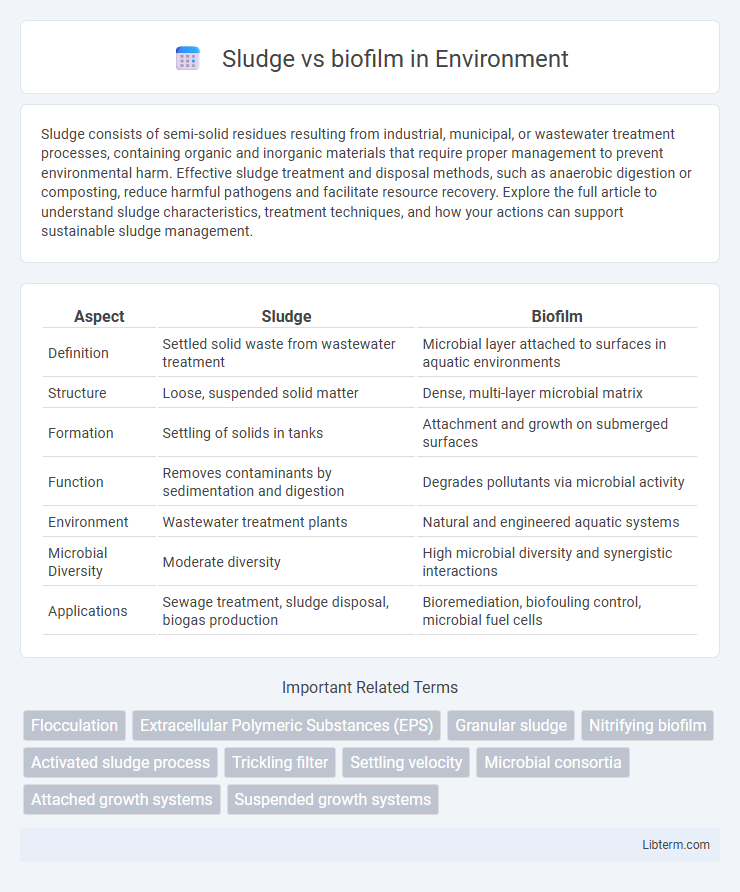Sludge consists of semi-solid residues resulting from industrial, municipal, or wastewater treatment processes, containing organic and inorganic materials that require proper management to prevent environmental harm. Effective sludge treatment and disposal methods, such as anaerobic digestion or composting, reduce harmful pathogens and facilitate resource recovery. Explore the full article to understand sludge characteristics, treatment techniques, and how your actions can support sustainable sludge management.
Table of Comparison
| Aspect | Sludge | Biofilm |
|---|---|---|
| Definition | Settled solid waste from wastewater treatment | Microbial layer attached to surfaces in aquatic environments |
| Structure | Loose, suspended solid matter | Dense, multi-layer microbial matrix |
| Formation | Settling of solids in tanks | Attachment and growth on submerged surfaces |
| Function | Removes contaminants by sedimentation and digestion | Degrades pollutants via microbial activity |
| Environment | Wastewater treatment plants | Natural and engineered aquatic systems |
| Microbial Diversity | Moderate diversity | High microbial diversity and synergistic interactions |
| Applications | Sewage treatment, sludge disposal, biogas production | Bioremediation, biofouling control, microbial fuel cells |
Understanding Sludge and Biofilm: Key Definitions
Sludge refers to the accumulation of suspended solids and microbial biomass in wastewater treatment processes, forming a dense, semi-solid mass. Biofilm is a structured community of microorganisms attached to surfaces, embedded in a self-produced extracellular polymeric substance (EPS) matrix. Understanding the fundamental differences between sludge as a loose aggregation and biofilm as a surface-attached microbial layer is essential for optimizing biological treatment efficiency and system design.
Formation Processes: How Sludge and Biofilm Develop
Sludge formation occurs through the aggregation of suspended solids and microbial biomass, primarily within wastewater treatment tanks where settling processes concentrate organic and inorganic particles. Biofilm develops as microorganisms attach to surfaces in moist environments, creating a complex, structured community embedded in a self-produced extracellular matrix. Both processes rely on microbial colonization but differ in spatial organization, with sludge forming flocs suspended in liquid and biofilms adhering to solid substrates.
Components and Structure: Sludge vs Biofilm
Sludge consists mainly of suspended solids, organic matter, microorganisms, and inorganic materials aggregated into flocs with a heterogeneous, loosely packed structure. Biofilm is a structured microbial community embedded in a self-produced extracellular polymeric substance (EPS) matrix, firmly attached to surfaces with a dense and layered architecture. While sludge particles are dispersed in liquid, biofilms exhibit spatial stratification that enhances nutrient gradients and microbial interactions.
Roles in Wastewater Treatment Systems
Sludge primarily functions as a dense aggregation of suspended solids, microorganisms, and organic matter responsible for the decomposition and stabilization of waste during the secondary treatment stage of wastewater systems. Biofilms, composed of microbial communities attached to surfaces, enhance nutrient removal through processes like nitrification and denitrification by maintaining a stable environment for microbial activity. Both sludge and biofilms play critical roles in reducing biological oxygen demand (BOD) and removing pathogens, but biofilms offer advantages in fixed-film reactors by providing higher biomass retention and resistance to toxic shocks.
Microbial Communities: Diversity and Functions
Sludge microbial communities exhibit high diversity with bacteria, archaea, and protozoa playing critical roles in organic matter degradation and nutrient cycling in wastewater treatment. Biofilm communities display layered structures where distinct microbial taxa specialize in different metabolic functions, enhancing resilience and stability under environmental fluctuations. The spatial organization in biofilms promotes syntrophic interactions, leading to efficient substrate utilization and biodegradation compared to suspended sludge microbes.
Operational Challenges: Sludge vs Biofilm
Sludge systems face operational challenges such as thickening, settling issues, and odor generation, which require frequent handling and disposal to maintain treatment efficiency. Biofilm systems encounter problems like clogging, uneven biofilm growth, and difficulty in controlling biofilm thickness, impacting oxygen transfer and nutrient removal rates. Both sludge and biofilm require careful monitoring of hydraulic retention time and substrate concentration to optimize treatment performance and prevent system failure.
Environmental Impact and Management
Sludge generated from wastewater treatment contains concentrated pollutants that can cause soil and water contamination if not properly managed, while biofilms contribute to environmental processes by naturally breaking down organic matter and pollutants. Effective sludge management involves stabilization, dewatering, and safe disposal or reuse to minimize greenhouse gas emissions and toxic leachate production. Biofilm-based technologies enhance environmental sustainability through improved pollutant degradation efficiency and reduced chemical usage in treatment systems.
Removal and Treatment Technologies
Sludge removal primarily relies on mechanical dewatering, gravity settling, and anaerobic digestion to reduce volume and stabilize organic matter. Biofilm treatment technologies utilize fixed-film reactors such as trickling filters, rotating biological contactors, and moving bed biofilm reactors (MBBR) for efficient pollutant removal through microbial communities attached to surfaces. Advanced methods integrating membrane bioreactors (MBR) enhance both sludge management and biofilm-based contaminant biodegradation, optimizing wastewater treatment performance.
Applications Beyond Wastewater Treatment
Sludge and biofilm play critical roles in environmental and industrial applications beyond wastewater treatment, including soil remediation and bioenergy production. Sludge, rich in organic matter and nutrients, is increasingly utilized as a biofertilizer to enhance soil health and crop productivity, while biofilms are exploited in bioreactors for the efficient breakdown of contaminants in bioremediation processes. Emerging research highlights the potential of engineered biofilms in biocatalysis, biosensors, and microbial fuel cells, showcasing their versatility in sustainable technology development.
Future Trends in Sludge and Biofilm Research
Future trends in sludge and biofilm research emphasize advanced microbial community engineering and enhanced biofilm reactor designs to improve wastewater treatment efficiency and resource recovery. Integration of omics technologies and machine learning models facilitates precise monitoring and management of microbial interactions within sludge and biofilms, optimizing biodegradation processes and minimizing environmental impact. Innovations in biofilm-based bioreactors and sludge valorization techniques aim to achieve sustainable treatment solutions aligned with circular economy principles.
Sludge Infographic

 libterm.com
libterm.com